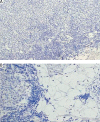Immunohistochemical characteristics of basal-like breast cancer
- PMID: 28239279
- PMCID: PMC5320452
- DOI: 10.5114/wo.2016.56938
Immunohistochemical characteristics of basal-like breast cancer
Abstract
Basal-like breast cancer (BLBC) occurs mainly in young patients. It is characterized by an aggressive clinical outcome, presence of distant metastases, particularly within the first five years of the disease, bad prognosis and relatively high mortality. Recently greater interest of scientists in this subtype of breast cancer has been observed. Despite such many well-known potential biomarkers of BLBC, currently there is no official international panel of antigens dedicated to diagnosis of this subtype of breast cancer. The most commonly used set in this case contains four antibodies - estrogen receptor (ER), epidermal growth factor receptor (EGFR) and human epidermal growth factor receptor 2 (HER2) and cytokeratins (CK) 5/6 - although it cannot provide one hundred percent detectability of these lesions. Incorporation of additional biomarkers into a panel can increase specificity, at the potential cost of sensitivity. Many biomarkers have been associated with the basal-like phenotype, and those with high sensitivity and/or specificity could improve the performance of immunohistochemical surrogate panels. Work on detection of the best of them is constantly being performed.
Keywords: basal-like breast cancer; immunohistochemistry; tumor markers.
Figures


References
-
- Haupt B, Ro JY, Schwartz MR. Basal-like breast carcinoma: a phenotypically distinct entity. Arch Pathol Lab Med. 2010;134:130–3. - PubMed
-
- Pollán M. Epidemiology of breast cancer in young women. Breast Cancers Res Treat. 2010;123(Suppl 1):3–6. - PubMed
-
- Niemeier LA, Dabbs DJ, Beriwal S, Striebel JM, Bhargava R. Androgen receptor in breast cancer: expression in estrogen receptor-positive tumors and in estrogen receptor-negative tumors with apocrine differentiation. Mod Pathol. 2010;23:205–12. - PubMed
Publication types
LinkOut - more resources
Full Text Sources
Other Literature Sources
Research Materials
Miscellaneous
